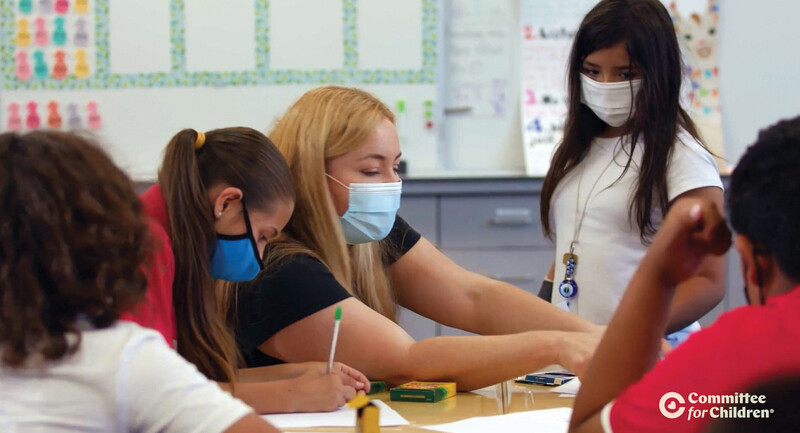It is early May. I look at my fifth-hour class and marvel at the climate of cooperation in a room full of 30 14–year-olds, hungry ones at that. They aren't disagreeing, sleeping, being insubordinate, or indifferent. They are enjoying learning and one another.Last year, i spent all my time trying to control my students. This year, the students know they matter. The negative attention-getting has stopped—there is no longer a need for it. They belong.
Judy Kirby, a teacher for 25 years, is describing her English class at Tomball High school in Tomball, Texas. Within the first two minutes, students are taking role, preparing attendance records, and arranging the room for their interaction groups.
Such student-centered activities, while common in early elementary classrooms, are rarely found in the upper grades. Too often, classroom management systems built on trust and support in the early grades are replaced with compliance and obedience systems in the latter grades, causing bright-eyed, eager 1st graders to become tourists in our schools by 3rd grade.
Tourists simply pass through without involvement, commitment, or belonging (Rogers and Freiberg 1994). In high school, a tacit agreement sometimes exists between teachers and students: “Leave me alone, and I won't give you trouble.” Inner-city classrooms, in particular, rely heavily on teacher control and student obedience.
The Consistency Management and Cooperative Discipline project seeks to turn tourists into citizens by helping educators create active classrooms, where cooperation, participation, and support are the cornerstones. These classrooms are neither totally teacher-centered nor totally student-centered: they are person-centered (see fig. 1).
Figure 1. Teacher-Centered Classrooms vs. Person-Centered Classrooms
From Tourists to Citizens in the Classroom - table
Teacher-Center Classrooms | Person-Centered Classrooms |
|---|
| Teacher is the sole leader | Leadership is shared |
| Management in a form of guidance | Management is a form of oversight |
| Teacher takes responsibility for all paperwork and organization | Students facilitate operations of the classroom |
| More students are “tourists” than “citizens” | More students are “citizens” than “tourists” |
| Discipline comes mostly from the teacher | Discipline comes mostly from the self |
| A few students are the teacher's helpers | All students can become an integral part of classroom management |
| Teacher posts the rules | Teacher and students develop rules in the form of a classroom constitution or Magna Carta |
| Consequences are fixed for all students | Consequences reflect individual differences |
| Rewards are mostly extrinsic | Rewards are mostly intrinsic |
| Students are allowed limited responsibilities | Students share in classroom responsibilities |
| Students see only people who are paid to be in school | Schools recruit business and community members to enrich opportunities for students and present positive role models for students |
—Adapted from Freedom to Learn (3rd ed.) by C. Rogers and H. J. Freiberg (1994, p.240). Used with permission.
Citizenship Through Experience
Consistency Management and Cooperation Discipline is a research-based, classroom-tested model that evolved from my own experiences as a classroom teacher. The program combines instructional effectiveness through consistency of organization in the classroom with student self-discipline developed cooperatively with teachers.
The program, used with more than 10,000 (K–12) Texas students and teachers from the inner-city to rural schools, gives teachers and administrators a flexible framework for improving the quality of instruction and learning environments. It incorporates five themes: prevention, caring, cooperation, organization, and community (Freiberg, in press). Each theme includes strategies and activities that allow students to become real partners in the classroom, some of which are illustrated here.
Prevention
Based on a decade of research, I've observed that 80 percent or more of classroom management is problem prevention rather than intervention. Teachers can prevent or minimize future discipline problems by spending time before school begins and during the first days and weeks establishing opportunities for students to achieve high standards for behavior. Consistency without rigidity in the classroom and throughout the school helps to raise expectations for behavior and learning.
For example, in September, teachers and students establish rules for learning based on mutual needs by developing classroom constitutions or Magna Cartas. Here's a sample statement from Tina smith's classroom: We the students are entitled to: learn, feel safe, complain to the grievance committee [which the class created along with the constitution], ask questions, speak freely, have friends, not be put down, be treated fairly, share our feelings, get help, understand, and be treated kindly.
All members of the classroom, including the teacher, sign the documents, which are in effect throughout the year. Such experiences enable students to test their own values and build important bridges to their future roles in society.
Caring
Students want to know how much you care, not how much you know. Authentic caring requires listening, reflecting, trusting, and respecting the learner. Honoring the child while correcting the behavior is an important first step. Students need positive models for caring, from both adults and one another.
One way that project teachers promote awareness of caring behaviors is by audiotaping their classrooms from time to time. After listening to the tone of the dialogue, teachers play the tapes for their classes. A discussion follows in which everyone identifies “killer statements” by students or teachers—for example, “That's a dumb question.” Everyone makes it a point to avoid similar negative comments in the future.
Project schools promote a caring climate through a variety of other ways. For example, administrators often teach classes, read stories, or share experiences with students, allowing students to see them as educators, not just disciplinarians. Schools also celebrate students' birthdays, a common practice in elementary but not middle and high schools. As part of the celebration, the faculty take pictures of students, on a voluntary basis, in front of a happy birthday sign. In addition, classrooms and hallways are filled with students' work, and classical music plays during writing time to indicate this is student time to think without interruptions.
Cooperation
Helping, sharing, participating, planning, and working together—these are the heart of a cooperative classroom. Cooperation leads to ownership, involvement, and greater opportunities for student self-discipline. But first must come trust.
Students learn to trust through opportunities to take ownership. Sergio, an 8th grader from an inner-city middle school, wrote this journal entry about starting the school day without a teacher: I feel lucky today because the day has just started and we have already been trusted in something we have never been trusted on, being alone. it is 8:15 and everything is cool. Nothing is even wrong...
When students become citizens of the school, they take responsibility for their actions and those of others. On the October day that Sergio wrote about, a student sent the attendance to the office, while another student reviewed the homework with the class and started classroom presentations scheduled for the day. When the substitute teacher arrived, the students were engaged in learning. They had been taking responsibility for class operations since September.
Organization
In project schools, classroom organization is a mutual responsibility that adds valuable teaching and learning time and builds student ownership and self-discipline. For example, one-minute student managers is an important element of the project.
Classroom management positions, which range from passing out papers to assisting the substitute teacher, are posted in the classroom, and students (in grades 3–12) complete job applications for them. Teachers review the applications and select students based on stated interests. Jobs are rotated every four to six weeks so that all students hold positions in the classroom. Many teachers also conduct job interviews. Younger students discuss their jobs. For example, in a bilingual classroom of 4–year-olds, the students decided that two shoelace managers were needed to save their teacher's back and to speed their exit to lunch.
At Sergio's middle school, a student attendance manager keeps the roll on the computer, while the teacher talks with other students. Next door, students decide the teacher was losing teaching time setting up printers. The Printer Manager describes the impact of her job on the teacher: Well, like today, since all of us had questions about our work and one of the printers was messing up. So instead of her wasting time in trying to fix the printer, she helped some kids and I fixed the printer. She was able to help a few kids instead of nobody.
Management positions are open to every students rather than a select few. The 40–plus one-minute jobs vary by the age of the students and needs of each classroom. During regular classroom meetings, students decide whether they need to add or delete jobs. When surveyed, teachers indicated that the one-minute jobs give them an average 30 more minutes of teaching time daily.
Students do not receive external rewards for their manager jobs. The work itself, and the accompanying interaction with the teach and peers, is its own reward. The decision to use behavior incentives in other parts of the program, however, is up to the teachers and administrators of each school. Some program schools use incentives; others do not.
The Consistency Management and Cooperative Discipline project recognizes that today's family patterns require diversified, flexible approaches to involving parents and other stakeholders. Project staff provide schools with a matrix of ideas for seeking outside participation.
Here are some examples. During the first week of school, some teachers invite parents to talk to students about how workplace rules relate to classroom rules. Project staff also provide teachers with supplies of prestamped cards on which to write positive notes to parents. Parents and grandparents can purchase a book dedicated to their child for his or her birthday. Other ideas include inviting parents to have lunch with their children, scheduling field trips with business mentors, and asking college students to discuss possible careers.
Children need to see other adults in school in addition to those who are paid to be there. They provide additional positive role models for students and validate the importance of education.
Professional Development
The Consistency Management and Cooperative Discipline project includes four phases of professional development: awareness, implementation, follow-up, and sustaining support. First, project staff provide awareness workshops for schools and districts. If teachers and administrators express interest and commitment to the project (70 percent of the faculty must vote for approval), the school moves to the second phase. School staff attend a weekend and a summer academy to learn how to use the program.
After school begins, project staff provide six monthly follow-up programs at the school. The fourth phase, sustaining support, occurs after the initial year. Teams of veteran teachers from the project school provide Consistency Management and Cooperative Discipline facilitators to new faculty members. The purpose of this final phase is to leave the expertise at the school and classroom level, rather than with the university-based program developer.
Positive Results
We've conducted a series of longitudinal studies to determine outcomes of the Consistency Management and Cooperative Discipline program. The findings are promising (Freiberg et al. 1990, Freiberg and Huang 1994, Freiberg et al. 1995, and Freiberg 1994).
For example, students of teachers using the program in low-performing inner-city elementary schools earned scores that are statistically significantly higher on national standardized tests and state-criterion reference tests than comparison students. Three years after their schools began the program, these students gained on average three-quarters of a year's achievement over comparison students.
Four years after the program had been in use, we found statistically significant differences in how students viewed their learning environments. Based on survey data, students in the program perceived their environments to be more positive than comparison students. In addition, the following were all significantly higher for program students than for comparison students: student involvement, task orientation, class order and class rules, instructional learning environment, teacher expectations and student expectations, and achievement motivation and academic self-concept.
Program schools also document significantly fewer classroom problems and discipline referrals to the principal's office. Before beginning the program, an inner-city elementary school with only 276 students had 109 student referrals to the office during the school year. After using the program, the school reported 19 referrals, 9 of which were from substitute teachers. Further, the rate of suspensions five years later of nonprogram students was double that of students whose teachers used the program.
A similar pattern is evident in two intermediate rural schools. Over three years, discipline referrals were down 40–60 percent, and students made statistically significant gains in achievement (recent unpublished data). Both schools won awards for academic excellence.
When implemented schoolwide and throughout a feeder pattern of schools (K–12), Consistency Management and Cooperative Discipline becomes a collaborative enterprise in which teachers and administrators help students move toward self-discipline as they progress through their school years. The program is currently being replicated with nine additional inner-city schools, including elementary, middle (1995096), and high school (1996). Two elementary schools have had the program since 1994–95. In these schools, student discipline referrals to the office are down 79 percent when compared to 1993–94 discipline referral data prior to the start of the program (recent unpublished data).
A Climate for Learning
Although we teach about democracy, we rarely practice it in our schools and classrooms. Consistency Management and Cooperative Discipline seeks to change this situation. Creating caring classrooms and supportive schools will improve opportunities for students to become citizens rather than tourists. In places where people respect them and care about them as individuals, students can learn to become informed and involved members of our democratic society.







